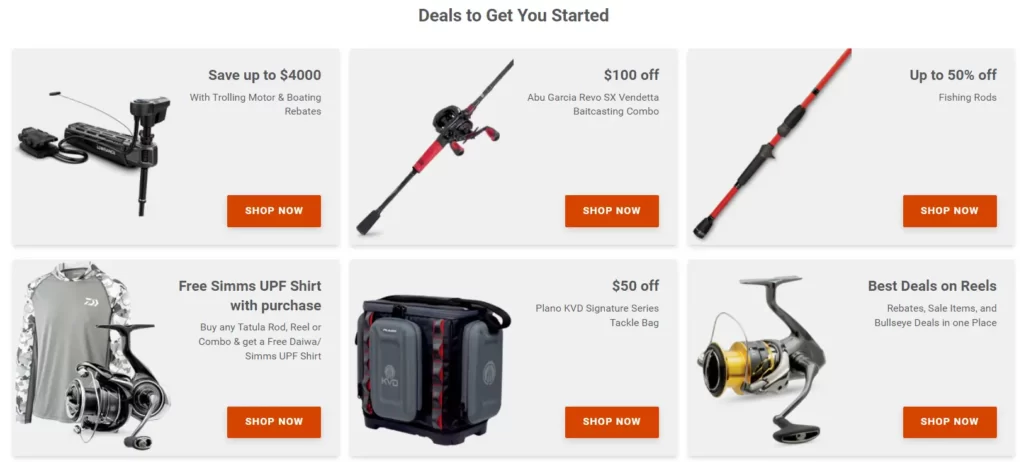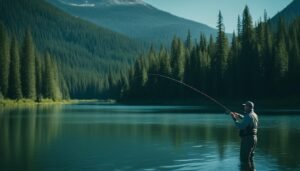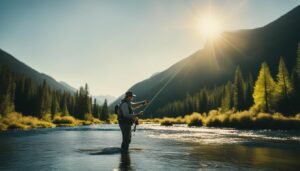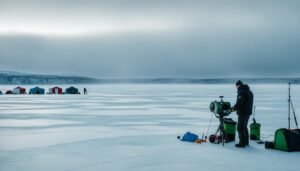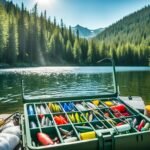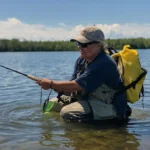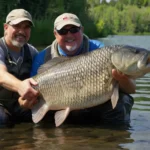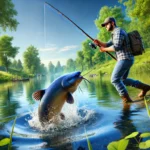Explore Canada's Ultimate Fishing, Hunting, and Wildlife Adventures

Expert Bass Fishing Tips for Successful Angling | Essentials Guide
Key Takeaways
🎣 Essential Bass Fishing Gear Recommendations: Use medium-heavy power rods with baitcasting reels, spool your reel with fluorocarbon line, and include a variety of baits and lures in your tackle box.
🐟 Choosing the Right Bait for Bass Fishing: Consider using live bait like minnows or artificial lures such as crankbaits, spinnerbaits, or topwater lures based on water clarity and weather conditions.
🎣 Basic Bass Fishing Techniques for Beginners: Master casting and retrieving techniques, learn to locate bass in weed beds and rocks, and experiment with various lures.
🎣 Advanced Bass Fishing Tips and Tricks: Explore finesse fishing, topwater techniques, specialized presentations, and insider tips to target trophy-sized bass effectively.
🐟 Largemouth Bass Fishing Strategies: Understand largemouth bass behavior, use the right techniques and bait, and target areas with submerged vegetation or high baitfish concentration.
🎣 Smallmouth Bass Fishing Techniques: Employ finesse fishing, topwater techniques, and specialized presentations to catch elusive smallmouth bass in colder, clearer water.
🎣 Pro Tips for Bass Fishing Success: Improve your bass fishing game by reading the water, understanding seasonal patterns, adapting to changing conditions, and focusing on detail.
🎣 Understanding Bass Feeding Patterns: Know what bass eat, when they eat, and where they feed to increase your chances of a successful catch.
🎣 Tips for Catch and Release Bass Fishing: Practice responsible catch and release, handle bass properly, and revive and release the fish with care.
🎣 Bass Fishing in Different Seasons: Adjust your fishing techniques based on the season—spring, summer, fall, and winter—to successfully catch bass.
🎣 Troubleshooting Bass Fishing Challenges: Overcome common challenges like fishing in pressured waters, dealing with finicky bass, and adapting to weather conditions.
🌃 Night Bass Fishing Techniques: Utilize the right gear, select dark-colored lures, familiarize yourself with the water, stay safe, be patient, optimize your bait presentation, and consider moon phase and weather for successful night fishing.
Looking to improve your bass fishing skills and increase your catch rates?
You’ve come to the right place. In this comprehensive essentials guide, we’ll provide you with a wealth of expert bass fishing tips and techniques to take your angling game to the next level.
Disclosure: When you purchase a service or a product through our links, we sometimes earn a commission, at no extra cost to you.
Whether you’re a beginner looking to learn the basics or an experienced angler seeking advanced strategies and insider secrets, we’ve got you covered. From gear recommendations and bait selection to specialized techniques and troubleshooting advice, this guide has something for anglers of all levels.
Table of Contents
Essential Bass Fishing Gear Recommendations
When it comes to bass fishing, having the right gear is essential to your success. The following recommendations will ensure that you’re equipped with everything you need to reel in those big ones.
| Item | Recommendation |
|---|---|
| Rod and Reel | Choose a medium-heavy power, fast action rod paired with a baitcasting reel. This will provide the necessary sensitivity and strength to feel every bite and handle the fight of a big bass. |
| Fishing Line | Spool your reel with a fluorocarbon line that has a test weight of 10-14 lbs. This type of line is virtually invisible underwater and has low stretch, allowing for better hooksets and sensitivity. |
| Baits and Lures | Include a variety of baits and lures such as topwater lures, crankbaits, soft plastics, and jigs. Make sure to select colors and sizes that match the local baitfish and water conditions. |
| Hooks and Weights | Use worm hooks for soft plastic baits and jig heads for jigs. Choose weights that are appropriate for the depth and current of the water you will be fishing. |
| Terminal Tackle | Be sure to have pliers, scissors, and a hook remover tool on hand for easy bait and hook changes. A tackle box or bag can also help keep your gear organized and easily accessible. |
When selecting gear, keep in mind the type of body of water you will be fishing, the time of year, and the behavior of the bass in that area. Experiment with different gear and techniques to find what works best for you and the conditions you will be fishing in.
Choosing the Right Bait for Bass Fishing
Choosing the right bait is crucial for successful bass fishing.
There are a variety of bait options available, from live bait to artificial lures. Understanding the different types of bait and their uses will help you select the best option for the conditions you are fishing in.
Live Bait: Live bait is a popular choice among bass anglers. Some of the most effective live bait options include minnows, worms, and crayfish. These baits can be rigged using a variety of techniques, including Carolina rigs and drop shot rigs. When using live bait, it’s important to keep it alive and healthy as long as possible to increase its attractiveness to bass.
Disclosure: When you purchase a service or a product through our links, we sometimes earn a commission, at no extra cost to you.
Artificial Lures: Artificial lures are a versatile and effective option for bass fishing. There are a variety of types, sizes, and colors available, including crankbaits, spinnerbaits, and jigs. Each type of lure mimics a different type of bass prey, such as shad or crawfish. Choosing the right color and size of lure depends on the water clarity, weather conditions, and time of day. As a general rule, darker colors work better in dark or stained water, while lighter colors work better in clear water.
Topwater Lures:
Topwater lures are a type of artificial lure that are designed to float on the water’s surface. These lures are very effective during early morning and late afternoon when the water is calm. Some of the most popular topwater lures include frogs, buzzbaits, and poppers. When using topwater lures, it’s important to reel them in at a slow and consistent pace to create realistic movement.
Fly to Your Canadian Fishing Paradise
Book cheap flights to Canada's best fishing spots!
One search, all flights
Find the best deals to your favorite fishing spots
Kiwi.com Guarantee
Travel worry-free with our protection
Trusted by millions
Join anglers booking cheap flights with ease
Disclosure: When you purchase a service or a product through our links, we sometimes earn a commission, at no extra cost to you.
Soft Plastic Baits:
Soft plastic baits are a type of artificial lure that mimics live bait. These baits come in a variety of shapes and sizes, including worms, lizards, and creature baits. Soft plastic baits are highly effective in clear water and can be rigged using a variety of techniques, including Texas rigs and Carolina rigs.
When choosing the right bait for bass fishing, it’s important to consider the water conditions, time of day, and the type of prey that bass are feeding on. Experimenting with different bait options and techniques will help you find the most effective combination for successful angling.
Basic Bass Fishing Techniques for Beginners
Mastering basic techniques is integral to successful bass fishing, particularly for beginners hoping to improve their catch rate.
Here are some fundamental techniques to get started with:
- Casting: Casting is a core skill in bass fishing. Practice regularly to improve your accuracy and distance.
- Retrieving: Retrieving is the process of bringing your bait back to the boat or shore. Experiment with different speeds and styles to see what works best.
- Locating bass: Understanding bass behavior and habitat is key to locating them. Look for structures such as weed beds, rocks, and drop-offs where bass may be hiding.
- Using a variety of lures: Lures are diverse in terms of their actions, color, and shapes. Experiment with different ones to know what attracts the bass you’re targeting.
Casting techniques for beginners
Mastering casting techniques will help you improve your accuracy and increase the chances of catching bass.
| Technique | Description |
|---|---|
| Straight-line cast | Keep the rod parallel to the water and cast straight ahead, allowing the lure to land gently. |
| Side-arm cast | Hold the rod parallel to the ground and swing it to your side before casting. |
| Overhead cast | Hold the rod vertically and flick it forward to cast the bait. |
Retrieving tips for beginners
Experimenting with different retrieval techniques can help draw in more bites. Here are a few to try:
| Technique | Description |
|---|---|
| Slow retrieve | Wind the lure in at a steady pace, allowing it to move naturally through the water. |
| Fast retrieve | Wind the lure in quickly to mimic a fleeing baitfish or provoke a reaction strike. |
| Stop-and-go retrieve | Wind the lure in, pause it and then wind it in again, varying the pause time to create a more erratic action. |
Applying these tips and techniques will help you get a head start on catching more bass. Remember, patience and practice will ultimately lead to success.
Advanced Bass Fishing Tips and Tricks
Bass fishing is a popular sport that requires a combination of skills, experience, and knowledge to excel. While basic techniques may be sufficient to catch small fish, experienced anglers know that advanced techniques are necessary to target trophy-sized bass.
In this section, we will explore some advanced bass fishing tips and tricks that can help you elevate your game and improve your success rates.
Finesse Fishing
Finesse fishing is a technique used to target bass in challenging conditions, such as heavily pressured waters or when bass are not actively feeding. This technique involves using light tackle, small lures, and subtle presentations to entice bites from small or inactive fish.
There are several finesse fishing techniques, including drop shotting, shaky head, and wacky rigging. These techniques require patience, finesse, and a keen eye for detail, but they can be highly effective when executed correctly.
Topwater Techniques
Topwater baits can be highly effective for catching bass, especially during the early morning and late evening hours when bass are most active. Using topwater baits requires a different approach than traditional techniques, as the angler must create a realistic and enticing presentation on the water’s surface.
Some popular topwater baits include buzzbaits, poppers, and walking baits. Successful topwater techniques involve rhythmic, repetitive motions that mimic the natural movements of prey, such as frogs or insects.
Specialized Presentations
Specialized presentations involve using unconventional techniques to target bass. These techniques may involve modifying lures or using unconventional bait choices, such as live bait or scented soft plastics.
One specialized presentation that has become increasingly popular is the Tokyo rig, which allows anglers to rig bait in a unique and highly effective way. This technique involves a specialized hook, split ring, and weight system that can be used with a variety of baits.
By using specialized presentations, anglers can differentiate themselves from other fishermen and increase their chances of catching elusive or heavily pressured bass.
Insider Tips and Secrets
Aside from advanced techniques, there are several insider tips and secrets that seasoned bass anglers employ to increase their success rates. These tips may involve choosing the right equipment, targeting specific areas of a body of water, or using knowledge of seasonal patterns to one’s advantage.
For example, some anglers may target areas with submerged vegetation or points with a high concentration of baitfish. Others may choose to fish during specific times of day or during specific weather conditions.
By employing insider tips and secrets, anglers can gain an edge over the competition and increase their chances of catching trophy-sized bass.
Largemouth Bass Fishing Strategies
Largemouth bass is one of the most popular game fish for anglers across North America. These fish prefer warm, shallow water, and are usually found in lakes, ponds, or slow-moving rivers. Proper knowledge of their preferred habitats, feeding patterns, and behavior can significantly increase the chances of a successful catch.
Here are some strategies for targeting largemouth bass:
Understand Their Behavior:
Largemouth bass are opportunistic feeders that will eat anything from small insects to frogs, crawfish, and even small mammals. They tend to hide in weeds, lily pads, and other types of vegetation where they can ambush their prey. Understanding their feeding patterns and preferred habitats is critical for anglers looking to catch these elusive fish.
Use the Right Techniques:
When targeting largemouth bass, it’s essential to use the right techniques. Topwater lures, such as frogs and buzzbaits, are great for fishing in shallow water or near the surface. Spinnerbaits and crankbaits are also effective for covering larger areas quickly and targeting fish that are hiding in submerged weed beds.
Choose the Right Bait:
The right bait can make all the difference when targeting largemouth bass. Live bait, such as minnows or nightcrawlers, can be effective, but artificial baits are often more convenient. Soft plastic lures, like worms and grubs, are versatile and can mimic the look and movement of many types of prey.
Employ Finesse Fishing Techniques:
When conditions are tough, and the fish are not biting, finesse fishing techniques can yield results. This method involves using smaller baits, lighter lines, and a slower retrieve, which can entice more cautious fish to bite.
Locate Trophy Fish:
If you’re looking to catch a trophy-sized largemouth bass, it’s crucial to target the right areas. Look for structures like submerged logs, rocks, or other underwater obstructions that offer shelter and cover for the fish. These areas are likely to hold larger, more mature fish.
Conclusion:
With the right techniques, bait, and knowledge of their behavior, largemouth bass fishing can be an exciting and rewarding experience. Using the tips and strategies outlined in this section can help anglers improve their chances of a successful catch.
Smallmouth Bass Fishing Techniques
Targeting smallmouth bass can be a challenging but rewarding experience for anglers. These fish are often found in colder, clearer water and can be more finicky than their largemouth counterparts.
Here are some advanced techniques to improve your smallmouth bass fishing success:
Finesse Fishing
When smallmouth bass are hesitant to bite, finesse fishing can be a game-changer. This technique involves using lighter line, smaller hooks, and more subtle presentations to entice bites. Drop shot rigs and wacky rigs are popular finesse techniques for smallmouth bass.
Topwater Techniques
While topwater fishing is often associated with largemouth bass, smallmouth bass can also be caught using surface lures. Popper and walking baits can be effective for targeting smallmouth bass in calm water conditions.
Specialized Presentations
Smallmouth bass can be trickier to catch than largemouth bass, so specialized presentations can be the key to success. Techniques such as jigging, drifting, and hopping bait along the bottom can be effective when targeting smallmouth bass in deep or rocky water. It’s important to experiment with different techniques until you find what works best for the specific conditions you’re fishing in.
Expert Tip: Smallmouth bass tend to move around more than largemouth bass, so it’s important to keep an eye on your fish finder and be prepared to adjust your presentation if necessary.
By using these advanced techniques, you can increase your chances of landing smallmouth bass and add some excitement to your fishing trips. Remember to always practice responsible catch and release techniques to preserve the health of the fishery.
Pro Tips for Bass Fishing Success
Maximizing bass fishing success requires more than just great gear and techniques. Seasoned anglers know that it’s often the small details that make a big difference.
Here are some pro tips to help elevate your bass fishing game:
Read the Water
One of the most important skills for any angler is the ability to read the water. This means paying close attention to details such as water temperature, clarity, and current. Look for areas where bass are likely to be feeding, such as drop-offs, weed lines, and shallow bays. By understanding the behavior of bass and their preferred habitats, you can increase your chances of landing a big catch.
Understand Seasonal Patterns
Bass behavior and feeding patterns vary depending on the season. During the spring, for example, bass are often found in shallower waters near the shore, while in the summer they may move to deeper, cooler waters. By understanding these seasonal patterns, you can adjust your techniques and bait choices to better target bass during different times of the year.
Adapt to Changing Conditions
Weather conditions such as wind, rain, and temperature can have a significant impact on bass behavior. When conditions change, it’s important to adapt your fishing tactics accordingly. For example, in windy conditions, you may need to use heavier lures or adjust your casting technique to compensate for the wind. Stay flexible and be willing to try new approaches when conditions change.
Develop Finesse Fishing Skills
Finesse fishing is a technique that involves using smaller lures and more subtle movements to entice bass to bite. It’s especially effective in heavily pressured waters or when bass are being picky. To develop your finesse fishing skills, experiment with different sizes and types of lures, and focus on making small, precise movements to mimic natural bait.
Pay Attention to Detail
When it comes to bass fishing, every detail matters. Pay attention to factors such as line visibility, lure color and size, and hook sharpness. Make sure your gear is in top condition, and take the time to properly rig your lures. By paying close attention to the small details, you can maximize your chances of landing a trophy-sized bass.
By incorporating these pro tips into your bass fishing strategy, you can take your angling skills to the next level. Remember to stay adaptable and always be willing to learn new techniques and strategies. With the right mindset and approach, you’ll be well on your way to bass fishing success.
Understanding Bass Feeding Patterns
One of the most important aspects of successful bass fishing is understanding their feeding patterns. By knowing what bass eat, when they eat, and where they feed, anglers can increase their chances of catching more fish.
Bass are opportunistic feeders, and their diet varies based on the time of year and available food sources. They generally eat smaller fish, insects, frogs, and crustaceans.
During warm weather, bass tend to be more active and feed more frequently. They may also feed throughout the day and night. In colder weather, bass will feed less often and may even become dormant during the winter months.
Water temperature also plays a significant role in bass feeding patterns. As the temperature rises, bass will become more active and feed more frequently. In cooler water, they may feed more selectively and less often.
It’s also important to consider how weather conditions can impact bass feeding patterns. On cloudy or overcast days, bass may be more active and feed more aggressively. Conversely, bright sunlight can make bass more cautious and less likely to feed.
To effectively target bass, anglers should pay close attention to their environment and look for signs of feeding activity such as jumping fish or bubbling water. Using the right bait, such as live bait or lures that mimic bass’ natural prey, can also maximize catch rates.
By understanding the feeding patterns of bass and adapting your fishing techniques accordingly, you can increase your chances of successful angling.
Tips for Catch and Release Bass Fishing
Catch and release bass fishing is an important practice for preserving the health and sustainability of bass populations. Whether you’re a seasoned angler or a beginner, it’s essential to understand the proper techniques for safely handling and releasing bass.
Handling Bass
When handling bass, it’s critical to minimize any harm or stress to the fish. Follow these tips to ensure safe handling:
| Tip | Description |
|---|---|
| Use wet hands | Wet your hands before handling the fish to avoid removing their protective slime layer. |
| Support the weight | Support the fish’s weight with your hands and avoid squeezing too hard. |
| Remove hooks quickly | Use pliers to remove hooks as quickly as possible, or cut the line if the hook is swallowed. |
| Avoid excessive handling | Minimize the time spent handling the fish and release it as quickly as possible. |
Releasing Bass
When releasing bass, it’s crucial to do so in a way that maximizes their chances of survival. Follow these tips for proper release:
- Revive the fish: Hold the fish in the water facing upstream and move it back and forth to help water flow through its gills. This process will help the fish regain strength and oxygen.
- Release the fish: Hold the fish gently in the water and release it once it is able to swim away on its own.
- Monitor the fish: Watch the fish swim away to ensure that it recovers fully and doesn’t become prey for larger fish.
Additional Tips
Here are some additional tips for successful catch and release bass fishing:
- Use barbless hooks: Barbless hooks are easier to remove and minimize the risk of injury to the fish.
- Avoid deep water: Fish caught in deep water are more likely to suffer from barotrauma, a condition that makes it difficult for them to swim back down after release.
- Use appropriate tackle: Use tackle that is appropriate for the size of fish you’re targeting to avoid overexerting the fish during the fight.
By practicing responsible catch and release, anglers can help preserve and protect bass populations for future generations of fishermen and women.
Bass Fishing in Different Seasons
Bass fishing strategies can vary greatly depending on the season. Understanding the behavior and feeding patterns of bass during each season can significantly improve your chances of a successful catch.
Here are some key techniques and tips to keep in mind when fishing for bass during different seasons.
Spring Bass Fishing
Spring is typically a great time to catch bass as they move into shallow waters to spawn. During this time, it’s important to use lures and bait that mimic the forage that bass commonly feed on in the spring, such as crawfish and shad. Here are some tips for spring bass fishing:
- Look for shallow areas near aquatic vegetation, as these are prime spawning grounds for bass.
- Try using soft plastic lures that imitate worms or lizards, as these are often effective in catching bass during this time.
- Be patient – bass may take some time to bite as they are often preoccupied with spawning activities.
Summer Bass Fishing
Summer can be a challenging time to catch bass, as they tend to move to deeper waters where it’s cooler. However, there are still some effective techniques that can be used to lure them into biting. Here are some tips for summer bass fishing:
- Look for drop-offs or ledges near weed beds, as these areas are often where bass will congregate in the summer.
- Try using topwater lures early in the morning or late in the evening, as these are often effective in attracting bass to the surface.
- Consider using live bait such as worms or crawfish, which can be more enticing to bass during the summer months.
Fall Bass Fishing
As the water begins to cool down in the fall, bass will move back towards shallow waters in search of food. This can make for some great catching opportunities, as bass become more active. Here are some tips for fall bass fishing:
- Look for areas with fallen trees or other structures, as these are often prime feeding grounds for bass during the fall.
- Try using crankbaits or spinnerbaits, as these lures can be effective in mimicking the forage that bass commonly feed on in the fall.
- Be prepared to try different techniques as bass may be more finicky during this season.
Winter Bass Fishing
Winter can be a challenging time to catch bass, as they tend to be less active and move to deeper, more sluggish waters. However, with the right techniques and gear, it’s still possible to catch them. Here are some tips for winter bass fishing:
- Look for deep drop-offs or channels near structure, as these are often where bass will congregate during the winter.
- Consider using jigs or spoons, which can be effective in getting down to deeper waters where bass are feeding.
- Be prepared to fish slowly, as bass tend to move and feed more slowly during the winter.
Troubleshooting Bass Fishing Challenges
Even the most seasoned bass anglers face challenges while fishing. However, understanding how to troubleshoot and overcome these obstacles can greatly improve your success rates. Here are some common challenges and solutions to help you address them:
| Challenge | Solution |
|---|---|
| Fishing in Pressured Waters | When fishing in pressured waters, try using less common bait options or techniques. You can also try fishing during off-peak hours when the waters are less crowded. |
| Finicky Bass | If the bass are not taking your bait, try changing your presentation technique, such as adjusting your retrieve speed or changing the bait’s color. Additionally, try downsizing your bait or switching to live bait if necessary. |
| Weather Conditions | Weather can greatly impact bass behavior. During overcast or rainy days, fish tend to move closer to the shore and become more active. During hot and sunny days, fish tend to move deeper in search of cooler water and will be less active. Adjust your fishing techniques accordingly based on the weather conditions. |
By keeping these troubleshooting tips in mind, you’ll be able to overcome bass fishing challenges with greater ease, improving your success rates and enjoying a more fulfilling fishing experience.
Night Bass Fishing Techniques
Nighttime bass fishing can be both challenging and rewarding. With the right techniques and gear, anglers can enjoy success in the dark hours. Here are some essential tips for night bass fishing:
- Use the right gear: Invest in high-quality fishing gear that is designed for night fishing. This should include a headlamp or other hands-free lighting, and a sturdy fishing rod with sensitive tip for detecting bites in low light conditions.
- Select the right bait: Bass are more likely to be attracted to dark-colored lures and baits at night. Choose lures that have a slow and steady swimming action, as this will mimic the movement of prey in low light conditions. Topwater lures and buzzbaits are also effective for drawing bass to the surface.
- Familiarize yourself with the water: Scout the area during daylight hours to identify potential fishing spots, hazards, and obstacles that may be difficult to see at night.
- Stay safe: Night fishing can be dangerous, so it is important to take precautions to stay safe. Always wear a life jacket, inform someone of your fishing plans, and be aware of your surroundings.
- Be patient: Night fishing generally requires more patience than daytime fishing. It may take longer for bass to bite, and strikes can be more difficult to detect. Stay focused and keep your bait in the water as much as possible.
- Optimize your bait presentation: Vary your retrieval speed and technique until you find what works best for the conditions. It may take some experimentation to determine the most effective presentation for the night.
- Pay attention to the moon phase: The moon can have a significant impact on bass behavior at night. During a full moon, bass may be more active and feeding in shallower water. Conversely, during a new moon, they may be deeper and less active.
- Consider the weather: Weather conditions can also have an impact on night fishing success. Bass may be more active during warm, humid nights, and less active during cold fronts or storms.
By applying these expert tips, anglers can improve their chances of catching bass during the nighttime hours. Stay safe, be patient, and experiment with different techniques to find what works best. Happy fishing!
FAQ about Bass Fishing Tips
If you’re new to bass fishing or just looking to improve your techniques, you may have a few questions. Here are some frequently asked questions about bass fishing tips:
What gear do I need for bass fishing?
To get started with bass fishing, you’ll need a few essential pieces of gear:
- A fishing rod and reel
- Baits and lures
- Hooks and weights
- Fishing line
It’s also a good idea to have polarized sunglasses, a hat, and sunscreen for protection from the elements.
What bait should I use for bass fishing?
The type of bait you should use depends on the conditions and the behavior of the fish. Common types of bait for bass fishing include:
- Plastic worms and grubs
- Jigs and spinnerbaits
- Crankbaits and topwater lures
You may want to experiment with different types of bait to see what works best for you and the fish in your area.
What are some basic techniques for bass fishing?
Some basic techniques to try include:
- Casting and retrieving your bait
- Using a slow, steady retrieve
- Varying your retrieval speed and technique
- Twitching or jerking your bait to mimic the movements of prey
It’s important to be patient and persistent when bass fishing, as it may take some time to locate the fish and figure out what works best.
How do I troubleshoot common bass fishing challenges?
If you’re having trouble catching bass, try adjusting your techniques or changing your bait. If you’re fishing in heavily pressured waters, try using unconventional baits or fishing in less crowded areas. If the fish are finicky, try using finesse techniques or downsizing your bait. Practice and experimentation can help you overcome common challenges and improve your success rate.
With these tips and strategies, you can improve your bass fishing techniques and enjoy a rewarding and fulfilling hobby. Happy fishing!
Resources and External Links
Here are some additional resources and external links that can help you learn more about “Bass Fishing Tips”:
Articles:
- Bass Fishing Tips: 9 Basics All Anglers Need to Know
- 30 Actionable Bass Fishing Tips & Tricks (How To Catch Bass)
- Bass Fishing for Beginners – Bass Fishing Resource Guide
- Bass Fishing Tips: How to Catch Bass | Discover Boating
- Catch 10x MORE Bass – TRY THIS! (Bass Fishing Tips) – YouTube
YouTube Videos:
- How To Catch Bass In The Heat! ( Its Easy! ) – TacticalBassin
- HOT Bass Fishing Tips For HOT Weather!! (DO FISH STILL BITE?) – TylersReelFishing
- The 5% Rule of BASS FISHING – BassFishingHQ
- Bass Fishing Tips ALL Beginners Should Know! #shorts – BigBite Bassin
These resources provide additional information and insights about “Bass Fishing Tips”.


